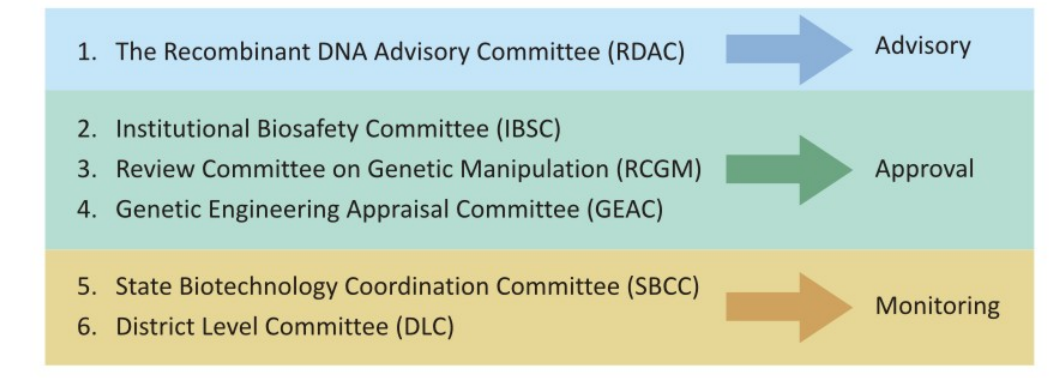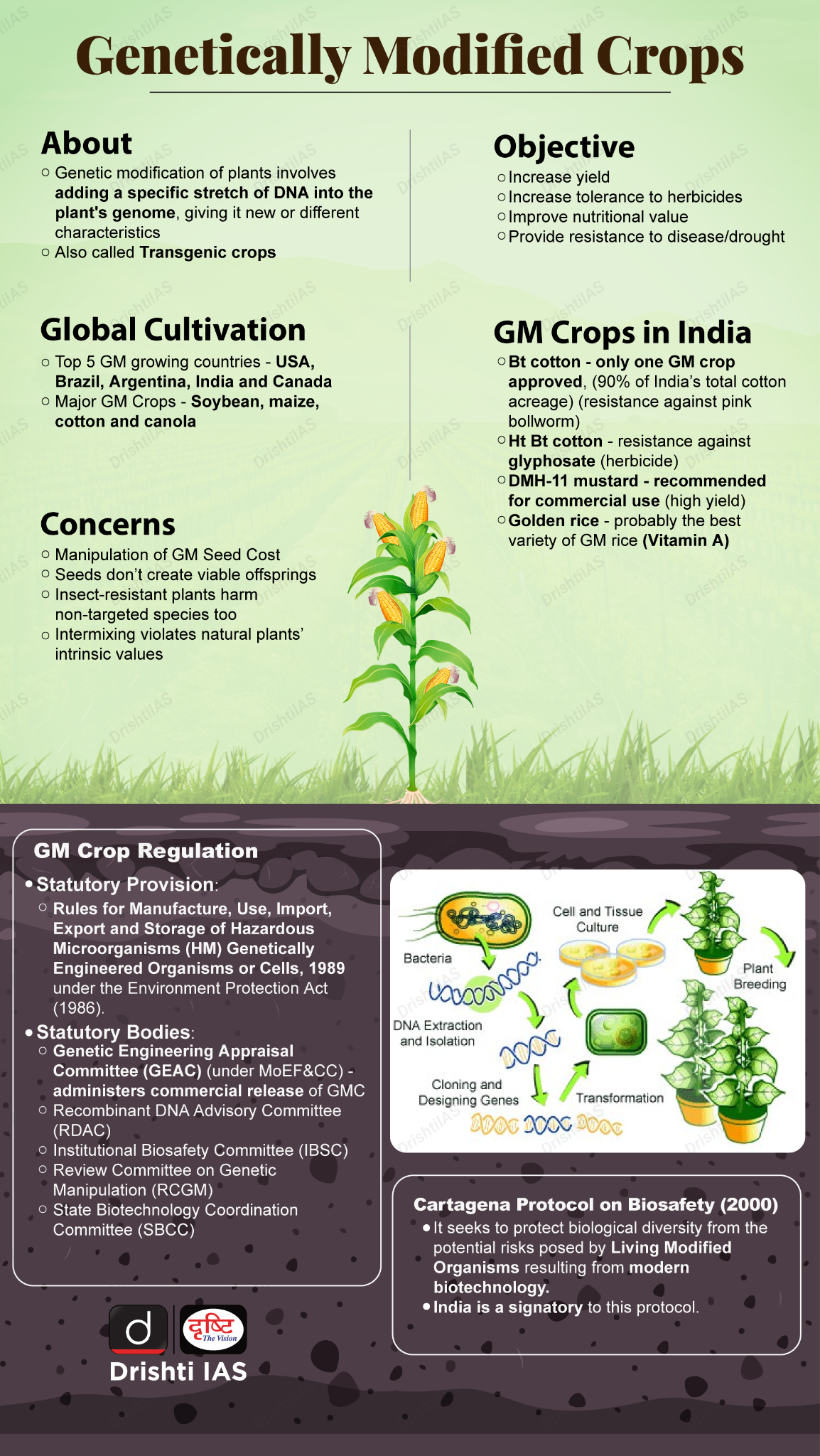Indian Economy
Exploring the Opportunities and Challenges of GM Crops
- 12 Jul 2025
- 13 min read
For Prelims: Genetically modified (GM) Mustard, Genetically Modified crops, Bt cotton, Drought-tolerant maize varieties, Golden Rice, C4 rice, Genetic Engineering Appraisal Committee, Environment Protection Act,1986, Intellectual Property Rights
For Mains: Regulatory Framework for GM Crops in India, Benefits and Issues Related to GM Crops
Why in News?
Amid ongoing trade negotiations, the US is pushing India to open its agriculture market to genetically modified (GM) crops. However, India has firmly stated that agriculture and dairy are 'sacrosanct red lines,' warning that allowing GM crop imports could threaten farmers' livelihoods and food safety.
What are Genetically Modified (GM) Crops?
- About: Genetically Modified (GM) crops are plants whose DNA is altered using modern genetic engineering technology to introduce or enhance desirable traits such as pest resistance, drought tolerance, or nutritional enhancement.
- Global Adoption: GM crops were first commercialized in the USA in 1994 with the Flavr Savr tomato, engineered to delay ripening.
- As per the International Service for the Acquisition of Agri-biotech Applications (ISAAA), by 2019, over 17 million farmers across 29 countries cultivated more than 190 million hectares of GM crops.
- Regulatory Framework in India: GM crops in India are regulated under the "Rules for the Manufacture, Use, Import, Export and Storage of Hazardous Microorganisms, Genetically Engineered Organisms or Cells" (Rules, 1989) under the Environment Protection Act,1986
- It provides a comprehensive regulatory framework for all activities involving GMOs, covering research and large-scale use, including manufacture, import, storage, sale, and export.
- They apply to genetically engineered organisms, related products, food items, and extend to new gene technologies like cell hybridization and genetic engineering, forming the basis of India’s biosafety regime.
What is the Status of GM Crop Adoption in India?
- Approved GM Crop: Bt cotton is the only genetically modified crop approved for commercial cultivation in India (since 2002). It now covers over 90% of India’s cotton area, around 12 million hectares.
- Bt cotton led to a 193% increase in production between 2002 and 2014, making India the second-largest global cotton exporter by 2011–12.
- It also contributed to higher farmer incomes and reduced pesticide use.
- Since 2015, cotton yields have declined from 566 kg/ha (2013–14) to around 436 kg/ha (2023–24).
- India now lags behind China and Brazil, with pest resurgence and absence of updated GM traits cited as key reasons.
- Pending GM Crop Approvals:
- Bt Brinjal: Approved by the Genetic Engineering Appraisal Committee (GEAC) in 2009, but placed under an ongoing moratorium due to public and political concerns.
- HT-Bt Cotton (Herbicide Tolerant): It is a herbicide-tolerant GM variant, is not approved for commercial use in India but is illegally cultivated in several states, including Gujarat, Maharashtra, Telangana, and Andhra Pradesh. It is estimated to cover 15–25% of total cotton acreage.
- GM Mustard (DMH-11): Granted environmental clearance in 2022, but its commercial release is on hold pending Supreme Court and regulatory approvals.
- Other Crops: GM variants of chickpea, pigeonpea, and sugarcane are at different stages of research, field trials, and regulatory deliberation.
What are the Key Benefits of Genetically Modified (GM) Crops?
- Enhanced Pest & Disease Resistance: GM crops like Bt cotton produce their own insecticides, effectively controlling pests like bollworms.
- Reduced pesticide use lowers costs, improves yields, and minimizes environmental harm, especially in pest-prone regions.
- Climate Resilience & Resource Efficiency: GM crops are developed to withstand drought, salinity, and heat, making them vital in the context of climate change.
- For instance, drought-tolerant maize in Kenya has improved yields in dry seasons.
- Additionally, GM crops like C4 rice and nitrogen-efficient variants aim to maximize output while using less water, fertilizer, and land.
- Nutritional Enhancement (Biofortification): GM technology enables the development of crops fortified with essential nutrients, addressing hidden hunger.
- Eg: Golden Rice (beta-carotene for Vitamin A), iron-rich rice, and zinc-enhanced wheat, targeting malnutrition in countries with limited dietary diversity and poor access to micronutrients.
- Reduced Post-Harvest Losses: GM crops with extended shelf life ( Flavr Savr tomato) help reduce post-harvest losses, especially in regions lacking refrigeration and cold storage.
- Herbicide-tolerant crops enable no-till farming, reducing soil erosion, carbon emissions, and preserving ecosystem health by minimizing pesticide use.
- Innovations in Medicine & Environmental Cleanup: GM crops are being researched for biopharming i.e producing vaccines and therapeutic compounds in plants like bananas and potatoes, potentially lowering healthcare costs and increasing access.
- Moreover, phytoremediation (use of plants to clean up environmental pollutants) using GM plants such as modified poplars helps absorb heavy metals and toxins.
What are the Key Challenges in GM Crop Adoption in India?
- Environmental and Health Concerns: GM crops may cause gene flow to wild species, leading to herbicide-resistant superweeds, while Bt crops can harm non-target insects and reduce biodiversity through monoculture.
- Health concerns include potential allergens, nutritional changes, and long-term safety highlighted by the StarLink corn incident (2000), where animal-feed-only GM corn entered the human food chain.
- Regulatory and Policy Constraints: India’s GM crop approvals are delayed due to regulatory opacity, prolonged moratoriums, and political hesitancy, even for scientifically cleared crops like Bt brinjal and GM mustard.
- Policies such as the Cotton Seed Price Control Order (2015) and mandatory tech transfer provisions have discouraged private R&D, hindering biotech innovation.
- Socio-Economic and Ethical Issues: There are concerns over market concentration, seed dependence, and high input costs for small farmers.
- Ethical issues such as “playing God”, food sovereignty, and community rights challenge public acceptance.
- Cases like Monsanto’s (US-based agricultural biotech company) enforcement of Intellectual Property Rights over GM seeds has led to global disputes over trait fees, seed sovereignty, and patentability, in India, the US and Canada.
- Coexistence, Contamination, and Illegal Cultivation: Coexistence of GM and non-GM crops poses challenges due to cross-pollination, risking organic certification and market access (Oregon GM wheat case, 2013).
- In India, HT-Bt cotton is illegally cultivated on up to 25% of cotton acreage, leading to biosafety risks and a black market for unregulated seeds.
- Resistance Development & Global Competitiveness: Overuse of GM traits has triggered pest and weed resistance, diminishing the effectiveness of Bt cotton and glyphosate-tolerant crops, requiring constant innovation.
- India’s declining cotton exports and turning net importer in 2024–25 signal a loss of global competitiveness due to delayed GM adoption and innovation stagnation.
What Measures Should be Taken for Responsible Adoption of GM Crops in India?
- Transparent, Science-Based Regulation: India should restructure its GM crop approval process to be time-bound, evidence-based, and managed by an independent authority with multi-stakeholder input.
- Ensure transparent field trials with public data access and independent oversight, along with long-term impact studies and regular ecological reviews to address biosafety and biodiversity.
- Strengthen PPP & Indigenous R&D: Promote collaborative biotech research through a Public-Private Partnerships (PPP) framework that balances innovation with public interest. Reform disincentives like the Cotton Seed Price Control Order (2015) and mandatory tech transfer norms.
- Support development of region-specific GM crops suited to Indian conditions and nutrition needs, with clear IPR-sharing mechanisms and increased funding for biofortified crop R&D.
- Inclusive and Responsible GM Crop Governance: Adopt farmer-centric policies ensuring access to quality seeds, training, insurance, and participation in decision-making, while preventing seed monopolies and preserving indigenous varieties through a national gene bank.
- Ensure coexistence of GM and non-GM crops via buffer zones and isolation distances, and implement robust GM labeling, public awareness, and strict enforcement against illegal cultivation.
- Global Standards & Nutrition Focus: Engage in international forums to harmonize biosafety norms and trade regulations. Prioritize biofortified GM crops like Golden Rice, iron-rich pulses, and zinc-enriched wheat to address micronutrient deficiencies. Launch pilot programs with health experts to demonstrate tangible health benefits.
Conclusion
India’s GM crop journey, marked by the success of Bt cotton and a prolonged policy deadlock reflects the tension between scientific potential and regulatory hesitation. In the face of climate challenges, nutritional deficiencies, and trade vulnerabilities, a science-driven, farmer-focused, and innovation-enabling approach is essential. As former PM Atal Bihari Vajpayee rightly said, “What IT is to India, BT is to Bharat”, a vision that must now be translated into action.
|
Drishti Mains Question How can genetically modified crops contribute to India’s food and nutritional security amid climate change and growing population? Evaluate the potential and risks associated with their widespread adoption. |
UPSC Civil Services Examination Previous Year Question (PYQ)
Prelims
Q1. Other than resistance to pests, what are the prospects for which genetically engineered plants have been created? (2012)
- To enable them to withstand drought
- To increase the nutritive value of the produce
- To enable them to grow and do photosynthesis in spaceships and space stations
- To increase their shelf life
Select the correct answer using the codes given below:
(a) 1 and 2 only
(b) 3 and 4 only
(c) 1, 2 and 4 only
(d) 1, 2, 3 and 4
Ans: (c)
Q2. Bollgard I and Bollgard II technologies are mentioned in the context of (2021)
(a) clonal propagation of crop plants
(b) developing genetically modified crop plants
(c) production of plant growth substances
(d) production of biofertilizers
Ans: (b)
Mains
Q. How can biotechnology help to improve the living standards of farmers? (2019)









